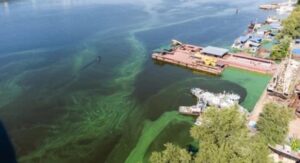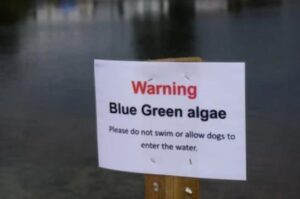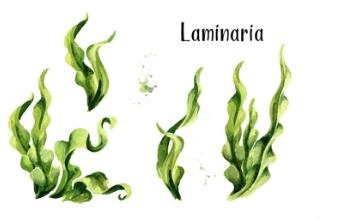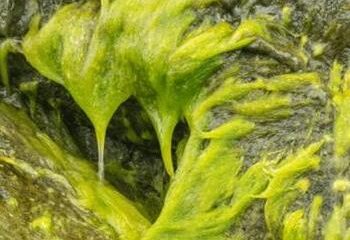Introduction
Blue-green algae, also known as cyanobacteria, are a diverse group of photosynthetic bacteria that inhabit various aquatic environments. Despite their name, they are not true algae but rather prokaryotic organisms. They play a significant ecological role as primary producers, contributing to the oxygenation of the Earth’s atmosphere through photosynthesis. Blue-green algae have a fascinating history and are crucial to the planet’s ecosystem.

Definition
Blue-green algae, or cyanobacteria, are prokaryotic photosynthetic microorganisms found in diverse aquatic environments. They are crucial to oxygenating Earth’s atmosphere through photosynthesis but can also cause harmful algal blooms due to rapid growth and toxin production.
Characteristics:
- Photosynthesis: Like plants, blue-green algae are photosynthetic organisms that utilize sunlight to convert carbon dioxide and water into organic compounds while releasing oxygen as a byproduct. This process is vital for maintaining the balance of atmospheric gases.
- Pigmentation: The characteristic blue-green color of these organisms is due to their photosynthetic pigments, including chlorophyll-a and phycocyanin. These pigments help them capture light energy for photosynthesis.
- Ancient Organisms: Blue-green algae are some of the oldest living organisms on Earth, dating back billions of years. They played a crucial role in shaping the planet’s early atmosphere and were among the first organisms to oxygenate the Earth, paving the way for the evolution of more complex life forms.
- Ubiquitous Distribution: Blue-green algae can be found in a wide range of environments, including freshwater, marine water, and terrestrial habitats. They thrive in both warm and cold climates, making them incredibly adaptable.
- Environmental Impact: While blue-green algae contribute positively to ecosystems by producing oxygen and serving as a food source for various aquatic organisms, they can also have negative impacts. Under certain conditions, some species of blue-green algae can undergo rapid growth or “blooms,” leading to harmful algal blooms (HABs). These blooms can produce toxins harmful to humans, animals, and other aquatic life, posing risks to public health and disrupting the balance of the ecosystem.
- Biotechnological Applications: Blue-green algae have gained attention in recent years for their potential applications in biotechnology. They can be used for various purposes, such as biofuel production, wastewater treatment, and the synthesis of valuable compounds like pharmaceuticals and bio-plastics.
Understanding blue-green algae is essential for studying ecological dynamics, environmental conservation, and exploring their potential in various industries. While they offer many benefits, their capacity for harmful algal blooms highlights the importance of monitoring and managing their populations in natural ecosystems.

Taxonomy and classification
The taxonomy and classification of blue-green algae, also known as cyanobacteria, are as follows:
Domain: Bacteria – Cyanobacteria belong to the domain Bacteria, as they are prokaryotic microorganisms lacking a membrane-bound nucleus.
Phylum: Cyanobacteria – Within the domain Bacteria, cyanobacteria form a distinct phylum called Cyanobacteria.
Class: Cyanophyceae – Cyanobacteria are further classified into the class Cyanophyceae. This class includes a wide range of cyanobacterial species with varying morphological and physiological characteristics.
Order: Various – The class Cyanophyceae is divided into multiple orders, each comprising several families of cyanobacteria.
Family: Various – Within each order, cyanobacteria are organized into different families based on their shared characteristics.
Genus: Various – Cyanobacterial species within a family are grouped into different genera based on their similarities.
Species: Specific epithet – The final level of classification is the species level, where each unique cyanobacterial organism is identified by a specific epithet. For example, a common cyanobacterial species is Microcystis aeruginosa.
It’s essential to note that cyanobacteria exhibit a high degree of diversity, and their taxonomy is continuously being refined as new research and molecular techniques provide more insights into their evolutionary relationships. Classification can be challenging due to their unique characteristics and evolutionary history, but scientists continually update their understanding of cyanobacterial taxonomy as more information becomes available.
Photosynthesis and oxygen production
Photosynthesis is a vital process carried out by blue-green algae, also known as cyanobacteria. Like plants, cyanobacteria use photosynthesis to convert carbon dioxide (CO2) and water (H2O) into organic compounds, particularly glucose, using sunlight as the energy source. The overall chemical reaction for photosynthesis in cyanobacteria can be represented as:
6 CO2 + 12 H2O + light energy → C6H12O6 (glucose) + 6 O2 + 6 H2O
In this process, light energy is absorbed by the photosynthetic pigments, such as chlorophyll-a and phycocyanin, present in the cyanobacterial cells. The energy is then used to drive a series of biochemical reactions that lead to the production of glucose, a simple sugar that serves as an essential source of energy and building blocks for the cyanobacteria.
Crucially, oxygen (O2) is released as a byproduct of photosynthesis. This oxygen release is significant as cyanobacteria were among the first organisms on Earth to produce oxygen through photosynthesis, contributing to the oxygenation of the early atmosphere. This event was a pivotal factor in enabling the evolution of aerobic organisms that require oxygen to survive, ultimately leading to the diversity of life forms we see today.
The process of photosynthesis and oxygen production in blue-green algae plays a critical role in maintaining the balance of atmospheric gases, supporting aquatic ecosystems, and influencing the overall Earth’s climate and environment. However, it’s important to note that while oxygen production is essential, some cyanobacterial species can also cause harmful algal blooms under certain conditions, leading to adverse ecological and health effects. Monitoring and understanding the dynamics of cyanobacterial populations are essential for managing their impact in natural environments.

Ecological importance
Blue-green algae, or cyanobacteria, hold significant ecological importance in various aquatic environments. Some of their key ecological roles include:
- Primary Producers: Cyanobacteria are primary producers, responsible for converting sunlight into organic matter through photosynthesis. They form the foundation of aquatic food chains, providing food for various aquatic organisms, such as zooplankton, small fish, and invertebrates.
- Oxygen Production: As mentioned earlier, blue-green algae play a crucial role in oxygenating the Earth’s atmosphere. Through photosynthesis, they release substantial amounts of oxygen, supporting the respiration of aerobic organisms and maintaining the balance of atmospheric gases.
- Nutrient Cycling: Cyanobacteria are involved in nutrient cycling within aquatic ecosystems. They fix atmospheric nitrogen, converting it into a form usable by other organisms. Additionally, their biomass contributes to nutrient availability in the water, aiding the growth of other aquatic plants and microorganisms.
- Habitat Formation: In some environments, cyanobacterial mats or colonies create physical structures that serve as habitats for a wide range of organisms. These structures offer shelter and breeding grounds for various aquatic species.
- Carbon Sequestration: Cyanobacteria play a role in carbon sequestration by removing carbon dioxide from the atmosphere during photosynthesis and converting it into organic matter. Some of this carbon becomes stored in sediments when cyanobacterial cells die and sink to the bottom of water bodies.
- Nitrogen Fixation: Cyanobacteria have the ability to fix atmospheric nitrogen, converting it into forms that can be utilized by plants and other organisms. This process is particularly essential in nitrogen-limited environments, where it enhances nutrient availability and promotes plant growth.
- Algal Blooms Regulation: While some cyanobacterial species can form harmful algal blooms under certain conditions, their presence in moderate amounts can help regulate the occurrence of more harmful algae. By competing for resources, cyanobacteria can suppress the growth of other harmful algal species.
- Water Clarity: In some cases, the presence of cyanobacterial blooms can reduce water clarity, impacting light penetration. However, in other situations, their filamentous structure can help improve water clarity by trapping suspended particles and reducing turbidity.
Overall, blue-green algae play a critical ecological role in aquatic environments, shaping nutrient cycling, providing food and habitat for various organisms, and contributing to the overall health and balance of aquatic ecosystems. However, their ecological impact can be both beneficial and detrimental, depending on their abundance and specific environmental conditions. Monitoring and understanding cyanobacterial populations are essential to maintain their ecological importance while managing the risks associated with harmful algal blooms.
Cyanotoxins
Cyanotoxins are toxic compounds produced by certain species of blue-green algae, or cyanobacteria, during harmful algal blooms (HABs). These toxins can have adverse effects on human health, animals, and other aquatic life. Cyanobacterial blooms can occur in various freshwater and marine environments, posing serious environmental and public health concerns. Some common cyanotoxins include:
- Microcystins: Microcystins are the most prevalent and widely studied cyanotoxins. They are hepatotoxins, meaning they primarily target the liver. Exposure to microcystins can lead to liver damage and can be harmful to both humans and animals. Microcystins can also have long-term health effects, including potential carcinogenic properties.
- Anatoxin-a: Anatoxin-a is a potent neurotoxin produced by certain cyanobacterial species. It acts as a nicotinic acetylcholine receptor agonist, leading to disruptions in nerve impulse transmission. Ingestion or contact with water containing anatoxin-a can cause muscle paralysis and even lead to death in severe cases.
- Cylindrospermopsin: Cylindrospermopsin is a cyanotoxin that can affect the liver, kidneys, and other organs. It can cause gastrointestinal symptoms, skin rashes, and in severe cases, liver damage and respiratory distress.
- Saxitoxins: Saxitoxins are potent neurotoxins commonly associated with harmful algal blooms known as “red tides.” They block nerve signals and can lead to paralytic shellfish poisoning (PSP) when ingested through contaminated shellfish.
- Brevetoxins: Brevetoxins are another class of neurotoxins associated with harmful algal blooms, particularly those caused by Karenia brevis. They can lead to neurotoxic shellfish poisoning (NSP) and have harmful effects on marine organisms and wildlife.
- Domoic Acid: Domoic acid is produced by some marine cyanobacterial species and is responsible for amnesic shellfish poisoning (ASP). It affects the nervous system and can lead to neurological symptoms in humans and animals.
These cyanotoxins can accumulate in water bodies during cyanobacterial blooms and may enter the food chain, affecting aquatic organisms and wildlife. Humans can be exposed to cyanotoxins through recreational water activities, drinking water contaminated by cyanobacterial blooms, or consuming fish or shellfish from affected areas.
To protect human health and the environment, it is crucial to monitor and manage cyanobacterial blooms and their associated cyanotoxins. Regular monitoring of water quality, public awareness, and implementing proper water treatment processes can help mitigate the risks posed by cyanotoxins in affected areas.

Biotechnological applications
Blue-green algae, or cyanobacteria, have garnered considerable interest in various biotechnological applications due to their unique characteristics and potential benefits. Some of the notable biotechnological applications of blue-green algae include:
- Biofuel Production: Cyanobacteria have the ability to produce lipids and carbohydrates through photosynthesis. Researchers are exploring ways to optimize their lipid production for the generation of biofuels, such as biodiesel or bioethanol. Cyanobacterial biofuel production offers a promising and sustainable alternative to traditional fossil fuels.
- Wastewater Treatment: Blue-green algae have the capability to remove nutrients like nitrogen and phosphorus from wastewater through a process called phytoremediation. This biotechnological application helps in treating nutrient-rich wastewater and reducing eutrophication in water bodies.
- Pharmaceutical Compounds: Cyanobacteria are known to produce a wide array of bioactive compounds, some of which have pharmaceutical potential. Researchers are studying cyanobacteria for the synthesis of antimicrobial agents, anti-cancer drugs, and other bioactive compounds.
- Nutritional Supplements: Certain cyanobacterial species are rich in proteins, vitamins, and minerals. They can be used as a source of nutritional supplements for humans and livestock, addressing malnutrition in vulnerable populations.
- Carbon Capture and Sequestration: Cyanobacteria can absorb carbon dioxide from the atmosphere during photosynthesis. Researchers are exploring the potential of using cyanobacteria to capture and sequester carbon as a means to mitigate climate change.
- Biofertilizers: Some cyanobacterial strains are effective nitrogen-fixers, converting atmospheric nitrogen into a form usable by plants. These cyanobacteria can be used as biofertilizers to enhance crop productivity while reducing the need for synthetic nitrogen fertilizers.
- Bioplastics: Cyanobacteria can synthesize biopolymers like polyhydroxyalkanoates (PHAs) that are biodegradable and can be used as an eco-friendly alternative to conventional plastics.
- Carbon-neutral Food Production: Incorporating cyanobacteria in aquaculture and hydroponics can help create a sustainable and carbon-neutral system for food production. Cyanobacteria can provide a natural source of nutrients and oxygen for aquatic organisms and plants.
- Environmental Sensing: Cyanobacteria can act as biosensors, responding to changes in environmental conditions such as pollutants or toxins. Their ability to produce detectable signals can be harnessed for environmental monitoring and early warning systems.
These biotechnological applications of blue-green algae hold immense potential in addressing environmental challenges, promoting sustainable practices, and providing solutions for various industries. As research and technology continue to advance, the full scope of cyanobacteria’s biotechnological contributions is likely to expand further.

Cyanobacteria and climate change
Cyanobacteria play a complex role in climate change, both as contributors and mitigators of its effects. Their influence on climate change is multi-faceted and can vary based on different factors. Some of the key aspects of cyanobacteria and climate change are:
- Carbon Dioxide Fixation: Cyanobacteria are photosynthetic organisms that can absorb carbon dioxide (CO2) from the atmosphere during photosynthesis. This process involves converting CO2 into organic matter, including carbohydrates and lipids. By doing so, cyanobacteria contribute to carbon sequestration, removing CO2 from the atmosphere and helping to mitigate the greenhouse effect.
- Oxygen Production: Through photosynthesis, cyanobacteria release oxygen (O2) into the atmosphere. The oxygen produced by cyanobacteria and other photosynthetic organisms is crucial for supporting aerobic life on Earth. It is estimated that cyanobacteria alone contribute to a significant portion of the global oxygen production.
- Feedback Effects: Climate change can influence the growth and distribution of cyanobacteria. Warmer temperatures, changes in precipitation patterns, and altered nutrient availability can affect the frequency and intensity of cyanobacterial blooms. Some species may thrive in warmer conditions, leading to an increase in harmful algal blooms in certain regions, which can further impact ecosystems and human activities.
- Albedo Effect: Cyanobacterial blooms in water bodies can affect the surface albedo, which refers to the reflectivity of sunlight. Dark-colored cyanobacterial blooms can lower the albedo, absorbing more sunlight and contributing to the warming of the water. This phenomenon can create positive feedback, where warmer water temperatures promote further cyanobacterial growth.
- Carbon Release: Under certain conditions, cyanobacterial blooms can die off and sink to the bottom of water bodies. The decomposition of this organic matter consumes oxygen, leading to hypoxia (low oxygen levels), and can release carbon dioxide and other greenhouse gases back into the atmosphere.
- Biofuels and Bioenergy: Cyanobacteria have been studied for their potential in biofuel production. By harnessing their ability to fix carbon dioxide and produce lipids, researchers aim to develop sustainable bioenergy sources that could reduce dependence on fossil fuels.
Understanding the interactions between cyanobacteria and climate change is essential for predicting the implications of their growth and distribution in a changing climate. While cyanobacteria can contribute positively by sequestering carbon and producing oxygen, their potential to exacerbate certain climate change effects through albedo changes and carbon release highlights the need for comprehensive research and monitoring of cyanobacterial populations. Managing cyanobacterial blooms and promoting sustainable practices are crucial for minimizing their impact on climate change and preserving the health of aquatic ecosystems.
Types
Blue-green algae, or cyanobacteria, comprise a diverse group of microorganisms with numerous species. While it is not possible to list all the individual species, I can provide you with some common types and genera of cyanobacteria:
- Microcystis: A common genus of cyanobacteria known for forming harmful algal blooms (HABs) in freshwater bodies. Some species in this genus produce hepatotoxins called microcystins.
- Anabaena: A filamentous genus of cyanobacteria that can fix atmospheric nitrogen and form nitrogen-fixing symbiotic associations with certain plants. Some species produce toxins, including anatoxin-a.
- Nostoc: A genus of cyanobacteria that often forms gelatinous colonies and can fix nitrogen. Some species of Nostoc are used as food sources in certain cultures.
- Spirulina: A filamentous and spiral-shaped cyanobacterium commonly used as a dietary supplement due to its high protein content and nutritional value.
- Oscillatoria: A genus of filamentous cyanobacteria found in various aquatic habitats. They are known for their oscillatory movement due to specialized cells called hormogonia.
- Aphanizomenon: A genus of cyanobacteria commonly found in freshwater lakes. Some species produce toxins and can form harmful algal blooms.
- Lyngbya: A filamentous genus of cyanobacteria often found in marine environments. Some species can produce toxic compounds.
- Synechococcus: A widespread and abundant genus of unicellular cyanobacteria found in both freshwater and marine environments.
- Prochlorococcus: A tiny, photosynthetic cyanobacterium found in the open ocean, playing a crucial role in the marine food web.
- Gloeocapsa: A genus of cyanobacteria commonly found on various surfaces, such as rocks, tree bark, and buildings.
These are just a few examples of the many cyanobacterial species and genera that exist. Cyanobacteria can be found in diverse habitats, including freshwater, marine water, soil, and even extreme environments like hot springs and deserts. Their wide distribution and ecological versatility make them important contributors to various ecosystems and biogeochemical cycles.
Conclusion
In conclusion, blue-green algae, or cyanobacteria, are a diverse and ecologically significant group of photosynthetic microorganisms. They play crucial roles in various ecosystems, serving as primary producers, oxygen producers, and nutrient recyclers. Their historical significance in shaping the Earth’s early atmosphere and their potential biotechnological applications make them subjects of extensive research. However, their capacity to form harmful algal blooms and produce cyanotoxins highlights the need for careful monitoring and management to mitigate their adverse effects. Understanding and appreciating the complex interactions between blue-green algae and the environment are essential for preserving the health of aquatic ecosystems and ensuring a sustainable future for our planet.
Answers/questions
Q1: What are blue-green algae?
A1: Blue-green algae, also known as cyanobacteria, are photosynthetic microorganisms found in various aquatic environments.
Q2: What is the ecological significance of blue-green algae?
A2: Blue-green algae play a vital role as primary producers, oxygen producers, and nutrient recyclers in aquatic ecosystems.
Q3: How do blue-green algae contribute to climate change mitigation?
A3: Blue-green algae sequester carbon dioxide from the atmosphere during photosynthesis, helping to reduce greenhouse gas levels.
Q4: What are harmful algal blooms, and how are blue-green algae involved?
A4: Harmful algal blooms (HABs) are excessive and harmful growths of algae. Blue-green algae can form HABs under certain conditions, releasing toxins that can be harmful to humans and aquatic life.
Q5: How can blue-green algae be used in biotechnology?
A5: Blue-green algae have potential applications in biofuel production, wastewater treatment, pharmaceuticals, bio-plastics, and carbon capture.
Q6: What are some common genera of blue-green algae?
A6: Some common genera of blue-green algae include Microcystis, Anabaena, Nostoc, Spirulina, and Synechococcus.
Q7: How does climate change impact cyanobacterial growth and distribution?
A7: Climate change can influence the frequency and intensity of cyanobacterial blooms due to changes in temperature, precipitation patterns, and nutrient availability.
Q8: What are cyanotoxins, and how do they affect the environment and human health?
A8: Cyanotoxins are toxins produced by some blue-green algae during harmful algal blooms. They can have harmful effects on the environment and pose health risks to humans and animals.
Q9: How can we manage and control harmful cyanobacterial blooms?
A9: Effective management strategies include monitoring water quality, reducing nutrient inputs, and implementing early warning systems to protect ecosystems and public health.
Q10: Why are blue-green algae essential for the evolution of life on Earth?
A10: Blue-green algae were among the first organisms to produce oxygen through photosynthesis, contributing to the oxygenation of the Earth’s early atmosphere and enabling the evolution of aerobic life forms.





certainly like your website but you need to take a look at the spelling on quite a few of your posts Many of them are rife with spelling problems and I find it very troublesome to inform the reality nevertheless I will definitely come back again